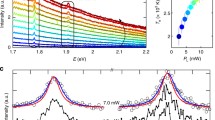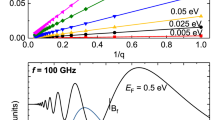Abstract
The pump–probe experiment is typically used to study relaxation phenomena in nonlinear optical systems. Here we use it as a tool to study the phenomenon of anomalous Rabi oscillations in graphene that was predicted recently in single-layer graphene. Unlike conventional Rabi oscillations, anomalous Rabi oscillations are unique to graphene (and possibly to surface states of topological insulators (TIs)), attributable to the pseudospin (conventional spin for TI) degree of freedom and Dirac-fermion character of the graphene system. A pump pulse of a finite duration long enough to contain a large number of cycles induces a current density that oscillates with the frequency of the pump pulse. The amplitude associated with these fast oscillations is seen to exhibit much slower oscillations with a frequency given by \({ 2 \omega ^2_{\mathrm {R}} }/{ \omega } \) – the anomalous Rabi frequency, where ω R is the conventional Rabi frequency and ω is the frequency of the external pump field. This effect is easily probed by a probe pulse subsequent to the pump, where it manifests itself as periodic oscillations of the probe susceptibility as a function of pump duration at each probe frequency. Alternatively, it is also seen as an oscillatory function of the pump–probe delay with other variables remaining fixed. This period corresponds to the anomalous Rabi frequency. An analysis of the previously reported experimental data confirms the presence of anomalous Rabi oscillations in graphene.


Similar content being viewed by others
References
K S Novoselov, A K Geim, S V Morozov, D Jiang, Y Zhang, S V Dubonos, I V Grigorieva, and A A Firsov, Science 306, 666 (2004)
A H Castro Neto, F Guinea, N M R Peres, K S Novoselov and A K Geim, Rev. Mod. Phys. 81, 109 (2009)
P R Wallace, Phys. Rev. 71, 622 (1947)
E McCann, D S L Abergel and V I Fal’ko, Eur. Phys. J. Special Topics 148, 91 (2007)
M Mucha-Kruczynski, E McCann and V I Fal’ko, Semicond. Sci. Technol. 25, 033001 (2010)
Enamullah, Vipin Kumar and Girish S Setlur, Physica B 407, 4600 (2012)
I I Rabi, Phys. Rev. 51, 652 (1937)
L Allen and J H Eberly, Optical resonances and two-level atoms (Wiley and Sons, New York, 1975)
H Haug and S W Koch, Quantum theory of optical and electronic properties of semiconductors, Fourth Edition (World Scientific, 2004)
D Frohlich, A Nothe and K Reimann, Phys. Rev. Lett. 55, 1335 (1985)
S Schmitt-Rink, D S Chemla and H Haug, Phys. Rev. B 37, 941 (1988)
C Ell, J F Muller, K El Sayed and H Haug, Phys. Rev. Lett. 62, 304 (1989)
J Shang, Z Luo, C Cong, J Lin, T Yu and G G Gurzadyan, Appl. Phys. Lett. 97, 163103 (2010)
P A George, J Strait, J Dawlaty, S Shivaraman, M Chandrashekhar, F Rana and M G Spencer, Nano Lett. 8, 4248 (2008)
D Sun, Zong-Kwei Wu, C Divin, X Li, C Berger, W A de Heer, P N First and T B Norris, Phys. Rev. Lett. 101, 157402 (2008)
B A Ruzicka, L K Werake, H Zhao, S Wang and K P Loh, Appl. Phys. Lett. 96, 173106 (2010)
J M Dawlaty, S Shivaramam, M Chandrashekhar, F Rana and M G Spencer, Appl. Phys. Lett. 92, 042116 (2008)
M Breusing, S Kuehn, T Winzer, E Malic, F Milde, N Severin, J P Rabe, C Ropers, A Knorr and T Elsaesser, Phys. Rev. B 83, 153410 (2011)
S Kumar, M Anija, N Kamaraju, K S Vasu, K S Subrahmanyam, A K Sood and C N R Rao, Appl. Phys. Lett. 95, 191911 (2009)
S Kumar, N Kamaraju, K S Vasu, A Nag, A K Sood and C N R Rao, Chem. Phys. Lett. 499, 152 (2010)
H Wang, J H Strait, P A George, S Shivaraman, V B Shields et al, Appl. Phys. Lett. 96, 081917 (2010)
R Ulbricht, E Hendry, J Shan, T F Heinz and M Bonn, Rev. Mod. Phys. 83, 543 (2011)
Q Chen et al, Scientific Reports 3(2315) (2013), DOI:10.1038/srep02315
A Das et al, Nature Nanotechnol. 3, 210 (2008)
M Farkas, Applied mathematical science 104: Periodic motions (Springer, New York, 2010)
S R Barone and M A Narcowich, Phys. Rev. A 15, 1109 (1977)
F Zhang, B Sahu, H Min and A H MacDonald, Phys. Rev. B 82, 035409 (2010)
L Tarruell, D Greif, T Uehlinger, G Jotzu and T Esslinger, Nature 483, 302 (2012)
D Hsieh, D Qian, L Wray, Y Xia, Y S Hor, R J Cava and M Z Hasan, Nature (London) 452, 970 (2008) D Hsieh, Y Xia, L Wray, D Qian, A Pal, J H Dil, J Osterwalder, F Meier, G Bihlmayer, C L Kane, Y S Hor, R J Cava and M Z Hasan, Science 323, 919 (2009)
Author information
Authors and Affiliations
Corresponding author
Rights and permissions
About this article
Cite this article
ENAMULLAH, KUMAR, V., KUMAR, U. et al. A theoretical study of pump–probe experiment in single-layer, bilayer and multilayer graphene. Pramana - J Phys 82, 1085–1101 (2014). https://doi.org/10.1007/s12043-014-0756-z
Received:
Revised:
Accepted:
Published:
Issue Date:
DOI: https://doi.org/10.1007/s12043-014-0756-z




